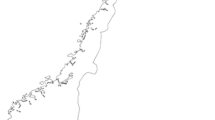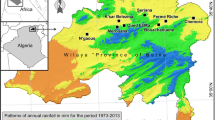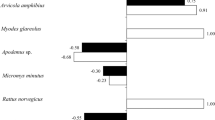Abstract
StoatsMustela erminea Linnaeus, 1758 and weaselsMustela nivalis Linnaeus, 1766 exploit the same array of prey species at different frequencies according to body size. The rabbitOryctolagus cuniculus, which typically is the dominant prey for stoats in temperate parts of Europe, is absent in Denmark. The present study based on gastrointestinal tract contents examines the food habits of sympatric stoats (n=112) and weasels (n=132) from Denmark. Rodents were the most important prey group for both stoats and weasels, constituting 77% and 84% of their diet respectively, expressed as frequency of occurrence. No differences were detected in the proportions of major prey groups between sexes within species, but between species the diets differed. Stoats ate birds and birds’ eggs more often than weasels did, while weasels ate more insectivores. Stoats ate more oftenMicrotus voles and water voleArvicola terrestris than weasels did, while weasels ate more bank voleClethrionomys glareolus and moleTalpa europaea. There was a larger dietary overlap between sympatric stoats and weasels in Denmark than in other dietary studies in areas where rabbits were available.
Similar content being viewed by others
References
Bonesi L. and Macdonald D. W. 2004. Differential habitat use promotes sustainable coexistence between the specialist otter and the generalist mink. Oikos 106: 509–516.
Brugge T. 1977. Prey selection of weasel, stoat and polecat in relation to sex and size. Lutra 19: 39–49. [In Dutch with English summary]
Cumberland R. E., Dempsey J. A. and Forbes G. J. 2001. Should diet be based on biomass? Importance of large prey to the American marten. Wildlife Society Bulletin 29: 1125–1130.
Day M. G. 1966. Identification of hair and feather remains in the gut and faeces of stoats and weasels. Journal of Zoology, London 148: 201–217.
Day M. G. 1968. Food habits of British stoats (Mustela erminea) and weasels (Mustela nivalis). Journal of Zoology, London 155: 485–497.
Dayan T. and Simberloff D. 1994. Character displacement, sexual dimorphism and morphological variation among British and Irish mustelids. Ecology 75: 1063–1073.
Debrot S. 1981. Trophic relations between the stoat (Mustela erminea L.) and its prey, mainly the water vole (Arvicola terrestris Scherman). [In: World Furbearer Conference Proceedings. J. A. Chapman and D. Pursley, eds]. Frostburg, Maryland: 1259–1289.
Debrot S. 1982. Atlas des poils de mammifères d’Europe. Institut de Zoologie, Univesité de Neuchâtel, Neuchâtel: 1–208.
Erlinge S. 1975. Feeding habits of the weaselMustela nivalis in relation to prey abundance. Oikos 28: 308–314.
Erlinge S. 1981. Food preference, optimal diet and reproductive output in stoatsMustela erminea in Sweden. Oikos 36: 303–315.
Erlinge S. 1987. Why do European stoatsMustela erminea not follow the Bergmann’s rule? Holarctic Ecology 10: 33–39.
Goszczyński J. 1999. Food composition of weasels (Mustela nivalis) in Poland. Mammalia 63: 431–436.
Jensen B. 2003. Occurrence of wild and domestic rabbit (Oryctolagus cuniculus) on the Danish islands. Flora og Fauna 109: 117–124. [In Danish with English summary]
Jensen A. and Jensen B. 1973. The stoat (Mustela erminea) and the weasel (Mustela nivalis) in Denmark. Dansk Vildtundersøgelser 21: 1–23. [In Danish with English summary]
King C. M. 1980. The weaselMustela nivalis and its prey in English woodland. Journal of Animal Ecology 49: 127–159.
King C. M. 1989. The natural history of stoats and weasels. Christopher Helm, London: 1–253.
King C. M. 1991. Body size — prey size relationship in EuropeanMustela erminea: a test case. Holarctic Ecology 14: 173–185.
King C. M. and Moors P. J. 1979. On co-existence, foraging strategy and the biogeography of weasels and stoats (Mustela nivalis andM. erminea) in Britain. Oecologia 39: 129–150.
Krebs C. J. 1999. Ecological Methodology. Addison Welsey Longman. New York: 1–620.
Martinoli A., Preatoni D. G., Chiarenzi B., Wauters L. A. and Tosi G. 2001. Diet of stoats (Mustela erminea) in an Alpine habitat: The importance of fruit consumption in summer. Acta Oecologica 22: 45–53.
McDonald R. A. 2002. Resource partitioning among British and Irish mustelids. Journal of Animal Ecology 71: 185–200.
McDonald R. A., Webbon C. and Harris S. 2000. The diet of stoats (Mustela erminea) and weasels (Mustela nivalis) in Great Britain. Journal of Zoology, London 252: 363–371.
Moors P. J. 1980. Sexual dimophism in the body size of mustelids (Carnivora): the roles of food habits and breeding systems. Oikos 34: 147–158.
Reynolds J. C. and Aebischer N. J. 1991. Comparison and qualification of carnivore diet by faecal analysis: a critique, with recommendations, based on a study of the foxVulpes Vulpes. Mammal Review 21: 97–122.
Sandeil M. 1989. Ecological energetics, optimal body size and sexual dimorphism: a model applied to the stoatMustela erminea L. Functional Ecology 3: 315–324.
Tapper S. 1979. The effects of fluctuating vole numbers (Microtus agrestis) on a population of weasels (Mustela nivalis) on farmland. Journal of Animal Ecology 48: 603–617.
Teerink B. J. 1991. Hair of West-European mammals. Atlas and identification key. Cambridge University Press, Cambridge: 1–224.
Author information
Authors and Affiliations
Corresponding author
Additional information
Associate Editor was Karol Zub.
Rights and permissions
About this article
Cite this article
Elmeros, M. Food habits of stoatsMustela erminea and weaselsMustela nivalis in Denmark. Acta Theriol 51, 179–186 (2006). https://doi.org/10.1007/BF03192669
Received:
Accepted:
Issue Date:
DOI: https://doi.org/10.1007/BF03192669




